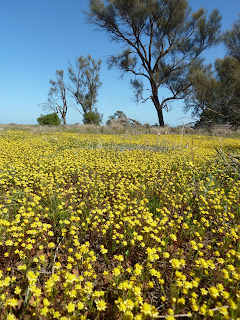And thinking. And observing some more. These are the fundamentals of doing ecology - figuring out the patterns in nature and the mechanisms/processes that underpin them.
And, it's the reason I got interested in ecology in the first place. Long before I knew anything about a GPS, or a Mixed Effects Model, or a molecular phylogeny, or a Powerpoint Presentation, I was interested in plants - their form and function (we'd now think of that as plant functional traits) - and their capacity to grow in interesting patterns (we'd probably call that species coexistence) and the controls of their seedling recruitment (that has always been called the regeneration niche). And, in many ways, that is still what drives my curiousity. Of course, that is now underpinned by ecologial theory and experience.
But the basics remain the same. A few days ago, I spent some time looking at semi-arid woodlands in northern Victoria in an area I'm not all that familar with. I visited a new Trust for Nature conservation reserve - Wanderer's Plain. And I was struck by how little I knew about the vegetation patterns in this area. There were stark changes from grassland, to woodland, to forest but I wasn't quite sure what was going on.
So, I made some notes and, married with photos, started to unravel the story.
At any new site I visit, I have a little checklist of things I ask myself: how does the topography change? How does the overstorey change? How does the understorey change? How does the soil change? By running through this list, I can start to arrange the components of the landscape into some sort of order. My geomorphologist friend Neville Rosengren calls this 'being able to read the landscape'. While he's looking at rocks and landforms, such a concept is equally applicable to the vegetation.
There were very subtle rises in the landscape, many no more than 100 cm above the surrounding plain, forming ribbon-like bands at semi-regular intervals. Here, the soils were sandy, a sure sign of some aeolian deposition from soils brought from the desert country to the north-west. On top of these rises grew Acacia melvillei (in full flower), but it was largely restricted to this area. Presumably the drainage here is excellent, and the fertility low.
 |
| Acacia melvillei in full flower, September 10 2012 (Photo: John Morgan) |
 |
| Fringing the Acacia is Buloke and tall native grasses (Photo: John Morgan) |
Fringing the Acacia band was an interesting zone of Buloke trees and tall C3 grasses. This occurs at the base of the sandy rises and a short distance into the plains, and I presume is a sort of run-on zone where water and fertility are both more readily available. Soils are likely to be better drained here than on the plain which appears to be composed of clays with very little topographical relief.
Away from the trees are native grasslands - flat and relatively featureless. But there is something going on. The grasslands here were looking spectacular. In large areas, the white-flowered Minuria leptophylla was the dominant herbaceous species. And, in other areas nearby, the yellow flowered annual daisy Hyalosperma semisterile was the dominant species. And rarely was there any co-dominance.
 |
| Hyalosperma semisterile - wildflower heaven! (Photo: John Morgan) |
 |
| Hyalosperma in the foreground, Minuria in the background (Photo: John Morgan) |
 |
| Minuria leptophylla (Photo: John Morgan) |
It suggests the way forward is an experiment. Another of my favourite ecological activities. Perhaps a seed sowing experiment, crossed with resource manipulations, to get to the heart of the patterns I've seen. And, undoubtedly, this will raise even more questions!